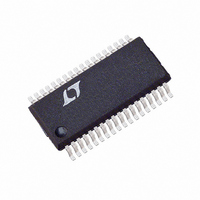LTC1709EG-8#TRPBF Linear Technology, LTC1709EG-8#TRPBF Datasheet - Page 12

LTC1709EG-8#TRPBF
Manufacturer Part Number
LTC1709EG-8#TRPBF
Description
IC SW REG STEP-DOWN SYNC 36-SSOP
Manufacturer
Linear Technology
Type
Step-Down (Buck)r
Datasheet
1.LTC1709EG-8PBF.pdf
(28 pages)
Specifications of LTC1709EG-8#TRPBF
Internal Switch(s)
No
Synchronous Rectifier
Yes
Number Of Outputs
2
Voltage - Output
1.3 ~ 3.5 V
Current - Output
3A
Voltage - Input
4 ~ 36 V
Operating Temperature
-40°C ~ 85°C
Mounting Type
Surface Mount
Package / Case
36-SSOP
Lead Free Status / RoHS Status
Lead free / RoHS Compliant
Power - Output
-
Frequency - Switching
-
Available stocks
Company
Part Number
Manufacturer
Quantity
Price
APPLICATIO S I FOR ATIO
LTC1709-8/LTC1709-9
Allowing a margin for variations in the LTC1709 and
external component values yields:
Operating Frequency
The LTC1709 uses a constant frequency, phase-lockable
architecture with the frequency determined by an internal
capacitor. This capacitor is charged by a fixed current
plus an additional current which is proportional to the
voltage applied to the PLLFLTR pin. Refer to Phase-
Locked Loop and Frequency Synchronization for addi-
tional information.
A graph for the voltage applied to the PLLFLTR pin vs
frequency is given in Figure 2. As the operating frequency
is increased the gate charge losses will be higher, reducing
efficiency (see Efficiency Considerations). The maximum
switching frequency is approximately 310kHz.
Inductor Value Calculation and Output Ripple Current
The operating frequency and inductor selection are inter-
related in that higher operating frequencies allow the use
of smaller inductor and capacitor values. So why would
anyone ever choose to operate at lower frequencies with
larger components? The answer is efficiency. A higher
frequency generally results in lower efficiency because
MOSFET gate charge and transition losses increase di-
rectly with frequency. In addition to this basic tradeoff, the
12
R
SENSE
Figure 2. Operating Frequency vs V
= 2(50mV/I
2.5
2.0
1.5
1.0
0.5
0
120
OPERATING FREQUENCY (kHz)
U
170
MAX
U
)
220
270
W
1709 F02
PLLFLTR
320
U
effect of inductor value on ripple current and low current
operation must also be considered. The PolyPhase ap-
proach reduces both input and output ripple currents
while optimizing individual output stages to run at a lower
fundamental frequency, enhancing efficiency.
The inductor value has a direct effect on ripple current.
The inductor ripple current I
decreases with higher inductance or frequency and
increases with higher V
where f is the individual output stage operating frequency.
In a 2-phase converter, the net ripple current seen by the
output capacitor is much smaller than the individual
inductor ripple currents due to ripple cancellation. The
details on how to calculate the net output ripple current
can be found in Application Note 77.
Figure 3 shows the net ripple current seen by the output
capacitors for the 1- and 2- phase configurations. The
output ripple current is plotted for a fixed output voltage as
the duty factor is varied between 10% and 90% on the
x-axis. The output ripple current is normalized against the
inductor ripple current at zero duty factor. The graph can
be used in place of tedious calculations, simplifying the
design process.
I
L
Figure 3. Normalized Output Ripple Current
vs Duty Factor [I
V
OUT
1.0
0.9
0.8
0.7
0.6
0.5
0.4
0.3
0.2
0.1
fL
0
0.1
1
0.2
V
0.3
DUTY FACTOR (V
V
OUT
IN
IN
RMS
0.4
or V
0.5
0.3 ( I
L
OUT
OUT
0.6
per individual section, N,
/V
:
IN
0.7
O(P–P)
1-PHASE
2-PHASE
)
0.8
1709 F03
)]
0.9















